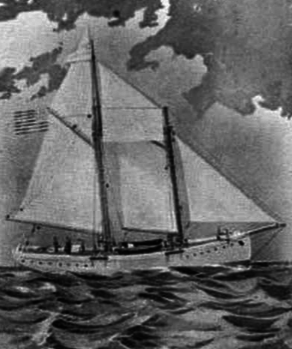Star of Oregon (ship) facts for kids

Star of Oregon
|
|
Quick facts for kids History |
|
|---|---|
| Laid down | 1840 |
| Launched | 1842, Willamette River, Oregon |
| Fate | sold 1843 in California |
| Notes | Details |
| General characteristics | |
| Class and type | schooner |
| Displacement | tons |
| Length | 53 ft 8 in (16.36 m) |
| Beam | 10 ft 9 in (3.28 m) |
| Draught | 4 ft 6 in (1.37 m) |
| Propulsion | sail |
The Star of Oregon was a special sailing ship from the 1800s. It sailed along the west coast of North America. This ship was the very first American sailing vessel built in what we now call Oregon. Pioneer settlers built the ship from 1840 to 1842. Their goal was to sail it to California and trade it for farm animals like cows. Later, during World War II, another ship called the SS Star of Oregon was named to honor this important 19th-century sailing vessel.
Contents
Building the Star of Oregon
The Star of Oregon was designed by Felix Hathaway, a skilled ship's carpenter. He got help from Joseph Gale, an American fur trapper who knew a lot about sailing. The Star was a small Baltimore clipper schooner. This type of ship was very easy to steer and could sail in shallow water.
Starting the Construction
Building the Star of Oregon began in the fall of 1840. Felix Hathaway led the work. Other settlers like John Canan, Ralph Kilbourne, and Pleasant Armstrong helped with the labor. They started building the schooner on the east side of Swan Island, which is now part of Portland, Oregon.
Challenges and Help
In the spring of 1841, the project faced problems. Hathaway quit because the group could not pay him. He also found other jobs and was frustrated by a lack of building materials. At this point, the ship's bottom part was mostly finished.
John Canan and Ralph Kilbourne then asked Joseph Gale for help. Gale had promised to assist and be the captain later on. Gale checked the ship and decided it could be seaworthy. He sold his farm and moved his family to Champoeg, Oregon. For the next year, Gale worked hard to finish the vessel.
Finishing the Ship
On May 19, 1841, the partly built ship was launched. It was moved up the Willamette River near Oregon City. By the fall of 1841, some partners left the project, leaving only five. Kilbourne and Gale did most of the remaining work. Thomas J. Hubbard did the metalwork.
Even though wood was easy to find in Oregon, other materials were needed. Things like ropes, canvas for sails, and paint were only available from the Hudson's Bay Company store at Fort Vancouver. The leader there, John McLoughlin, was not eager to help the American settlers.
The project was saved when Lieutenant Charles Wilkes arrived in Oregon. He was the commander of the United States Exploring Expedition. Wilkes asked McLoughlin to sell the needed materials to the Americans as a favor. McLoughlin agreed. So, the builders bought ropes, canvas, and paints. They paid with wheat and furs. Work continued until late October 1841, then stopped for the winter. In June 1842, work started again. The ship was ready to sail by mid-August, almost two years after they began building it.
Voyage to California
In August 1842, the Star of Oregon was ready for its big trip. Joseph Gale was the captain. The crew included John Canan, Ralph Kilbourne, and Jacob Green. They sailed south along the coast. Their goal was to reach California and trade the ship for livestock.
Trading the Ship
When they arrived in Yerba Buena (which is now San Francisco), Gale and his crew found a man named Joseph Yves Limantour who needed a ship. Limantour was a French merchant whose own ship had crashed in 1841. He was stuck in California without a way to transport his goods.
Limantour wanted the Star of Oregon. Gale and his partners wanted cattle. So, they made a three-way deal. General Mariano Guadalupe Vallejo, a powerful leader in California, bought the Star of Oregon for 350 cows. Then, he gave the ship to Limantour. The Star of Oregon was renamed the Jóven Fanita to honor General Vallejo's seven-year-old daughter, Epifania.
The Jóven Fanita
In late 1842, Limantour loaded the Jóven Fanita with his remaining goods. He sailed down the coast, stopping at places like Monterrey and Santa Barbara. In January 1843, he arrived at San Pedro. There, he met the new Governor of California, Manuel Micheltorena.
The Governor needed money and supplies for his soldiers. Limantour provided goods to the Governor. He then sailed to Mazatlán, Mexico, and returned with more goods for Micheltorena. Limantour continued to use the schooner until it eventually became a total wreck.

